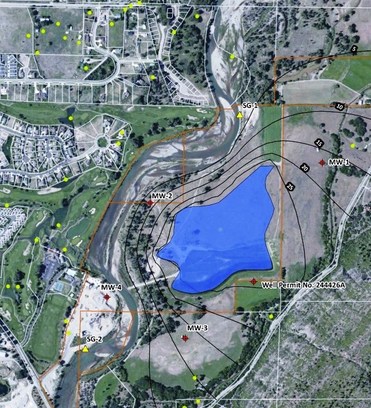
Hydrologic Impact: Aggregate Mine
La Plata County, Colorado
Western Water & Land performed a hydrologic impact assessment for an aggregate mining company in western Colorado. The assessment was required to support an application for an amendment to an existing mine permit. The study focused on the potential impacts to private well owners as a result of dewatering operations at the mine. The evaluation was first completed by defining the local geology and hydrogeology using published geologic maps, well information data obtained from Division of Water Resources (DWR’s) well construction reports, and previous hydrologic and subsurface studies completed for the mine. The dewatering impacts were then evaluated using a site specific numerical groundwater model.
The numerical model was developed using Groundwater Vistas Version 4 graphical user interface to the USGS program MODFLOW (McDonald and Harbaugh, 1988). The modeling approach consisted of first developing a “Base Model” to evaluate potential drawdown impacts. The base model reflects site conditions based on existing, available data. The base model was run under steady-state conditions without dewatering to provide the initial conditions for the transient dewatering simulations. Dewatering operations were simulated by making time-variable changes to the model during transient runs. External time-variable recharge and discharge sources were not considered. Assigned aquifer properties and model boundaries were then varied as part of a sensitivity analysis to evaluate the alternative model configurations and to determine the properties and boundaries to which the model results are most sensitive. Using the base model and alternate configurations with the sensitivity analysis provided a possible range of observed spatial and temporal drawdown effects. The model output was used to delineate the areas in which water level drawdown in response to dewatering could cause adverse impacts to private water wells. A groundwater monitoring and response plan was prepared to provide timely recognition and mitigation of impacts to local water well users resulting from groundwater level declines attributed to dewatering operations at the mine.
La Plata County, Colorado
Western Water & Land performed a hydrologic impact assessment for an aggregate mining company in western Colorado. The assessment was required to support an application for an amendment to an existing mine permit. The study focused on the potential impacts to private well owners as a result of dewatering operations at the mine. The evaluation was first completed by defining the local geology and hydrogeology using published geologic maps, well information data obtained from Division of Water Resources (DWR’s) well construction reports, and previous hydrologic and subsurface studies completed for the mine. The dewatering impacts were then evaluated using a site specific numerical groundwater model.
The numerical model was developed using Groundwater Vistas Version 4 graphical user interface to the USGS program MODFLOW (McDonald and Harbaugh, 1988). The modeling approach consisted of first developing a “Base Model” to evaluate potential drawdown impacts. The base model reflects site conditions based on existing, available data. The base model was run under steady-state conditions without dewatering to provide the initial conditions for the transient dewatering simulations. Dewatering operations were simulated by making time-variable changes to the model during transient runs. External time-variable recharge and discharge sources were not considered. Assigned aquifer properties and model boundaries were then varied as part of a sensitivity analysis to evaluate the alternative model configurations and to determine the properties and boundaries to which the model results are most sensitive. Using the base model and alternate configurations with the sensitivity analysis provided a possible range of observed spatial and temporal drawdown effects. The model output was used to delineate the areas in which water level drawdown in response to dewatering could cause adverse impacts to private water wells. A groundwater monitoring and response plan was prepared to provide timely recognition and mitigation of impacts to local water well users resulting from groundwater level declines attributed to dewatering operations at the mine.
